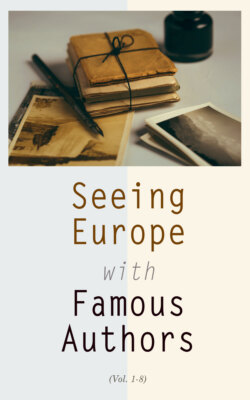Читать книгу Seeing Europe with Famous Authors (Vol. 1-8) - Гарриет Бичер-Стоу - Страница 28
LICHFIELD 1 By Nathaniel Hawthorne
ОглавлениеI know not what rank the Cathedral of Lichfield holds among its sister edifices in England, as a piece of magnificent architecture. Except that of Chester (the grim and simple nave of which stands yet unrivaled in my memory), and one or two small ones in North Wales, hardly worthy of the name of cathedrals, it was the first that I had seen. To my uninstructed vision, it seemed the object best worth gazing at in the whole world; and now, after beholding a great many more, I remember it with less prodigal admiration only because others are as magnificent as itself. The traces remaining in my memory represent it as airy rather than massive. A multitude of beautiful shapes appeared to be comprehended within its single outline; it was a kind of kaleidoscopic mystery, so rich a variety of aspects did it assume from each altered point of view, through the presentation of a different face, and the rearrangement of its peaks and pinnacles and the three battlemented towers, with the spires that shot heavenward from all three, but one loftier than its fellows.
Thus it imprest you, at every change, as a newly created structure of the passing moment, in which yet you lovingly recognized the half-vanished structure of the instant before, and felt, moreover, a joyful faith in the indestructible existence of all this cloudlike vicissitude. A Gothic cathedral is surely the most wonderful work which mortal man has yet achieved, so vast, so intricate, and so profoundly simple, with such strange, delightful recesses in its grand figure, so difficult to comprehend within one idea, and yet all so consonant that it ultimately draws the beholder and his universe into its harmony. It is the only thing in the world that is vast enough and rich enough.
Inside of the minster there is a long and lofty nave, transepts of the same height, and side-aisles and chapels, dim nooks of holiness, where in Catholic times the lamps were continually burning before the richly decorated shrines of saints. In the audacity of my ignorance, as I humbly acknowledge it to have been, I criticized this great interior as too much broken into compartments, and shorn of half its rightful impressiveness by the interposition of a screen betwixt the nave and chancel. It did not spread itself in breadth, but ascended to the roof in lofty narrowness.
A great deal of white marble decorates the old stonework of the aisles, in the shape of altars, obelisks, sarcophagi, and busts. Most of these memorials are commemorative of people locally distinguished, especially the deans and canons of the cathedral, with their relatives and families; and I found but two monuments of personages whom I had ever heard of—one being Gilbert Walmesley, and the other Lady Mary Wortley Montagu, a literary acquaintance of my boyhood. It was really pleasant to meet her there; for after a friend has lain in the grave far into the second century, she would be unreasonable to require any melancholy emotions in a chance interview at her tombstone. It adds a rich charm to sacred edifices, this time-honored custom of burial in churches, after a few years, at least, when the mortal remains have turned to dust beneath the pavement, and the quaint devices and inscriptions still speak to you above. …
A large space in the immediate neighborhood of the cathedral is called the Close, and comprises beautifully kept lawns and a shadowy walk, bordered by the dwellings of the ecclesiastical dignitaries of the diocese. All this row of episcopal, canonical, and clerical residences has an air of the deepest quiet, repose, and well-protected, tho not inaccessible seclusion. They seemed capable of including everything that a saint could desire, and a great many more things than most of us sinners generally succeed in acquiring. Their most marked feature is a dignified comfort, looking as if no disturbance or vulgar intrusiveness could ever cross their thresholds, encroach upon their ornamented lawns, or straggle into the beautiful gardens that surround them with flower-beds and rich clumps of shrubbery. The episcopal palace is a stately mansion of stone, built somewhat in the Italian style, and bearing on its front the figures of 1687, as the date of its erection. A large edifice of brick, which, if I remember, stood next to the palace, I took to be the residence of the second dignitary of the cathedral; and in that case it must have been the youthful home of Addison, whose father was Dean of Lichfield. I tried to fancy his figure on the delightful walk that extends in front of those priestly abodes, from which and the interior lawns it is separated by an open-work iron fence, lined with rich old shrubbery, and overarched by a minster-aisle of venerable trees.
1 From "Our Old Home." Published by Houghton, Mifflin Co.
